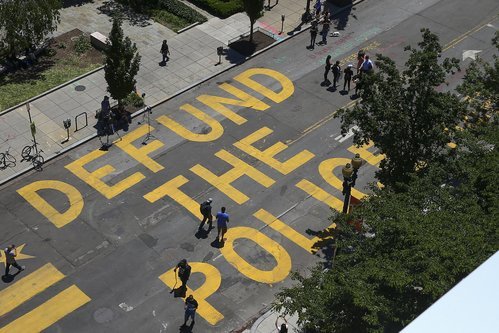What the US would look like without police, as imagined in 3 scenarios

Americans alive today have never lived in a country without police.
But, sparked by the death of yet another black man at the hands of police, there’s a growing movement to create a police-free America — or at least one that dramatically scales back the role of police. The movement supports shifting the responsibility to uphold societal order to communities and investing money in them, too. It’s a model of policing, some activists point out, many affluent white Americans already experience.
The hope is that stronger infrastructure — and the absence of traditional law enforcement that many in the movement believe unfairly targets black Americans — will reduce crime and deaths at the hands of police.
The movement to pare back the role of police isn’t a monolith, though.
There are abolitionists who advocate for dissolving existing police departments and removing police from society, like organizers with the Minneapolis police abolitionist group MPD150.
There are defunders, who want to shrink police departments and their budgets and reinvest those resources in communities without getting rid of police entirely. Los Angeles Police Commission President Eileen Decker already made a small concession by pledging that between $100 million to $150 million cut from the LAPD budget would be “identified to further enhance community neighborhood policing efforts.”
And there are those who sit somewhere in between. They want to radically reimagine public safety without police, but they acknowledge that defunding is often the first step toward the dissolution of law enforcement as we know it.
Supporters in all three camps support shifting traditional criminal justice away from punishment and imprisonment to one of reform and rehabilitation.
But there’s no precedent for a police-free US, or at least a US where the role of police is limited.
To crystallize the concept, CNN posed three scenarios to experts and activists in the movement and asked how they’d be handled in an America without police.
Patrisse Cullors, co-founder of Black Lives Matter
Philip McHarris, a doctoral candidate in sociology and African American Studies at Yale University and lead research and policy associate at the Community Resource Hub for Safety and Accountability
Alex Vitale, a professor of Sociology and Coordinator of the Policing and Social Justice Project at Brooklyn College and author of “The End of Policing”
The organizers with MPD150 are staunch abolitionists. Cullors and McHarris believe in the abolition of police, too, but they also acknowledge that defunding is the first, crucial step. And Vitale supports strictly limiting the role of police so they’re needed only to respond to dangerous threats.
A traffic stop
Most Americans’ contact with police comes during a traffic stop, according to the Bureau of Justice Statistics. But as recent data proves, routine traffic stops can turn antagonistic for black drivers.
Police pull over black drivers 20% more often than white drivers, according to the Stanford Open Policing Project, which analyzed nearly 100 million traffic stops between the years of 2001 and 2017. The data also shows that black and Hispanic drivers were searched about twice as often as white drivers on average. Searches of black and Hispanic drivers were often based on less evidence.
And a 2018 Bureau of Justice Statistics report, which cited data from 2015, found that when police initiated contact, they were more likely to threaten or use physical force against blacks and Hispanics than whites.
Click here to see an extended interview about this scenario.
A domestic violence call
About 1.3 million domestic violence incidents happened between 2006 and 2015, a Bureau of Justice Statistics report found. Although 56% of those incidents were reported to police, the offender was only arrested or charged 39% of the time.
The offender was arrested or charges were filed during the initial police response in just 23% of those reported incidents, the report found.
Many domestic violence victims feel uncomfortable contacting the police for help. A 2015 National Domestic Violence Hotline survey of more than 600 women who had experienced partner abuse found that more than half of respondents said that calling the police would “make things worse.”
About 80% of participants who hadn’t previously called police were “somewhat or extremely afraid” to call in the future, 70% were afraid that calling would make things worse and 59% were afraid that police wouldn’t believe them.
The survey responses don’t reflect the efficacy of law enforcement’s response to domestic violence, but they do suggest that victims lack trust in police to effectively handle their cases.
Click here to see an extended interview about this scenario.
A school shooting
School shootings are a terrible feature of American life, and the US hasn’t been able to stop them. Over the last two decades, lawmakers have paid to bolster police presence in schools, a largely unstudied solution, to prevent gun violence. But the problem of school shootings remains, even with more school resource officers on US campuses.
Initiatives that have involved police, like hiring school resource officers and installing metal detectors haven’t been shown to decrease the likelihood of school shootings, and many of those measures were installed without evidence to support their efficacy, according to a 2017 review of studies on safety measures enacted over the last two decades.
After the Columbine High School shooting in 1999, Congress allocated more than $800 million between 1999 and 2005 to support the hiring of over 7,000 school resource officers.
And after the Sandy Hook Elementary School shooting in 2012, the Justice Department’s Office of Community Oriented Policing Services dispersed $125 million among more than 260 cities and counties to create new law enforcement positions to protect schools.
Click here to see an extended interview about this scenario.
